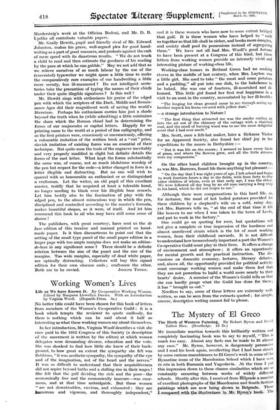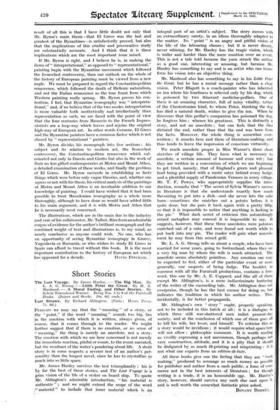The Mystery of El Greco
The Birth of Western Painting. By Robert Byron and David Talbot Rice. (Routledge. £2 2s.) MY immediate reaction -towards -this brilliantly written and completely fascinating book was to, say to myself, ." This is much too easy. Almost any facts can be "made to fit almost any case." Mr. Byron, however, is dangerously persuasive and I read his book again, recollecting that I had been struck by some curious resemblances to El Greco's-work in some of the Byzantine icons of the Macedonian School which I have seen in situ in both Rumania and Yugoslavia. At the time I put this impression down to those chance similarities which are so constantly occurring between works of widely different schools. Shortly after this, I received from MIgrade a number of excellent photographs of the Macedonian and South Serbian paintings which are now being shown in Belgrade. These I-compared with the illustrations in .Mr. Byroq's book, The
result of all this is that I have little doubt not only that Mr. Byron's main thesis—that El Greco was the last and greatest of the Byzantines—is satisfactorily proved, but also that the implications of this erudite and provocative study are substantially accurate. And I think that it is these implications which are the most important issue raised.
If Mr. Byron is right, and I believe he is, in making the dawn of " interpretational," as opposed to " representational," painting begin with the Byzantine movement which followed the Iconoclast controversy, then our outlook on the whole of the history of European painting must be viewed from a new angle. We must be prepared to regard the Constantinopolitan renascence, which followed the death of Hellenic naturalism, and not the Italian renascence as the true fount from which Western painting really sprang. Mr. Byron proves his con- tention, I feel, that Byzantine iconography was " interpreta- tional," and, if we believe that of the two modes interpretation is more valuable both aesthetically and intellectually than representation as such, we are faced with the point of view that the four centuries from Masaccio to the French Impres- sionists are a loop-way which leaves and rejoins the original high-way of European art. In other words Cezanne, El Greco and the Byzantine painters have a common factor which is not shared by " representational " painters.
Mr. Byron divides his monograph into five sections : his subject and its relation to modern art, the Iconoclast controversy,' the Constantinopolitan renascence which cul- minated not only in Duccio and Giotto but also in the work of their no less gifted contemporaries at Mistra and Mount Athos, detailed examination of these works, and finally the problem of El Greco. Mr. Byron succeeds in establishing as facts things which were before only vague theories, and, whether one agrees or not with his thesis, his critical analysis of the paintings at Mistra and Mount Athos is an invaluable addition to our knowledge of painting. I could have wished that it had been possible to treat Macedonian iconography as a whole more thoroughly, although to have done so would have added little to his main argument, and it is with Mistra and Athos that he is necessarily most concerned.
The illustrations, which are in the main due to the industry and care of his collaborator, Mr. Talbot, Rice form an admirable corpus of evidence for the author's brilliant monograph and the combined weight of text and illustrations is, to my mind, as nearly conclusive as anyone could wish. No one, who has an opportunity of seeing Byzantine iconograpy in Greece, Yugoslavia or Rumania, or who wishes to study El Greco in Spain can afford to travel without this book. It is the most important contribution to the history of European art which
























































 Previous page
Previous page